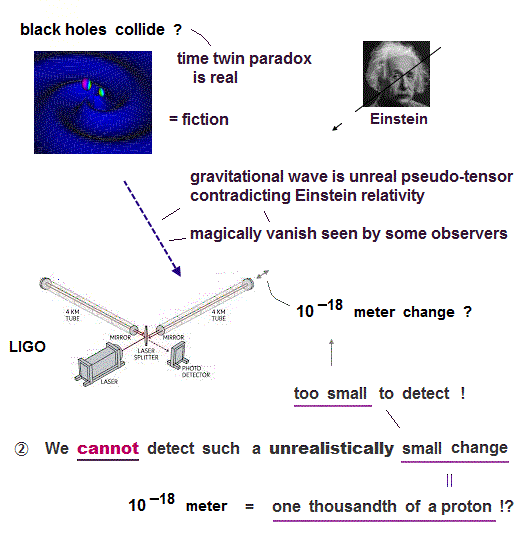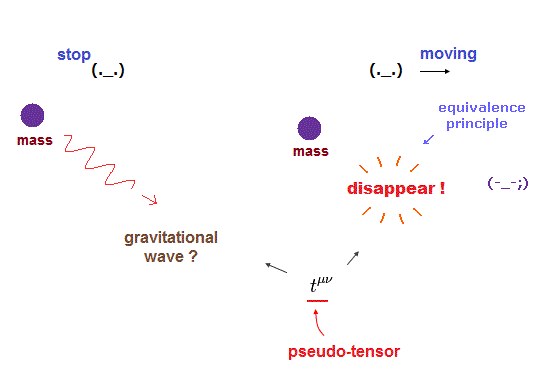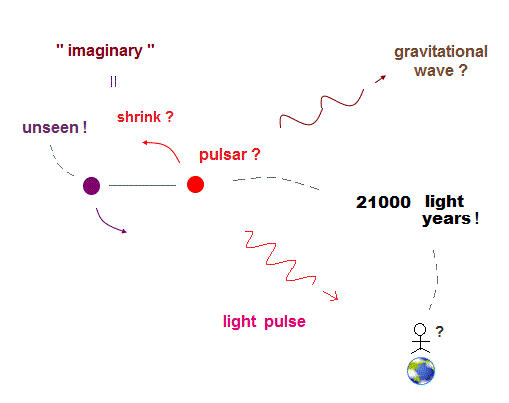
(Fig.1) The (fictional) gravitational wave could change the LIGO 4km-arm by only 1/1000 of a tiny proton's radius ? ← This change is too tiny to measure. so No evidence of gravitational wave, which is useless.

Gravitational wave allegedly emitted by collision of black holes is unreal, because the time stop around the black holes prevents black holes from colliding and forming, as seen by distant observers on the earth ( this-5th-paragraph, this-2nd-paragraph ).
The gravitational wave, which is too weak to measure, is said to change the LIGO 4km arm by only 1/1000 of a proton radius (= unrealistically-small, only 10-18 m change compared to the tiny proton's radius of 10-15 m ).
↑ The wavelength of light (= about 10-6m or 1 μm ) used for detecting this (illusory) tiny gravitational wave by interference is much, much longer than the proton radius ( this-8th-paragraph, this p.3-4th-paragraph, this p.12-last-paragraph ), which cannot detect such a tiny gravitational wave's change by light interference.
These too weak useless (illusory) gravitational waves are said to change the length between the earth and Sun by only one hydrogen atomic radius ( this 5th-paragraph, this-p.1-4th-paragraph ), which is impossible to measure except in the hyped news.
(Fig.2) Gravitational wave disappearing as seen by some observers is unreal.

Einstein general relativity has fatal flaws, it cannot conserve energy or carry wave ( this p.5-last, this p.5-last-paragraph, this p.2-(2) ).
This p.16-3rd-paragraph says -- Wrong general relativity
"in GR (= general relativity ) energy-momentum is No longer conserved in
general"
General relativity unable to conserve energy is why physicists had to artificially introduce unphysical concepts called "pseudo-tensor (= Not real tensor of Einstein relativity, this 4-6th paragraphs, this p.1-right-middle )" as doubtful gravitational wave which contradicts Einstein theory ( this p.13-14, this p.1, this p.1-middle-3rd~5th-paragraphs ).
Gravitational wave (= pseudo-tensors ) is illusion, unrealistically vanishing as seen from different coordinates or observers ! this p.19-last-paragraph, this-intro-1st-3rd-paragraphs )" contradicting Einstein original relativistic tensors.
This-p.2-1st-paragraph says -- Gravitational wave vanish
"gravitational
waves, pseudotensors globally vanish in some coordinates."
This p.1-3rd-paragraph says -- Pseudo-tensor vanish
"Unlike a tensor, a
pseudotensor (= gravitational wave ) can vanish at a point in one coordinate system (= seen by some observers )"
↑ Because when some observers may detect gravitational wave (= fictitious pseudo-tensor ) at the detector on the earth, other observers moving differently can Not observe the same gravitational wave (= pseudo-tensor ) even by using the same detector, due to gravitational wave unrealistically vanishing seen by some observers, which is fatal relativistic paradox.
Physicists can artificially create and choose many different forms of gravitational wave's unphysical pseudo-tensors ( this p.2-lower ), which means the artificially-created gravitational wave (= unphysical pseudo-tensor), which contradicts Einstein relativity, cannot be used to test Einstein relativistic prediction.
This p.5-3rd-paragraph says -- Artificial choice, No prediction
"Because there are many possible stress-energy tensors and pseudotensors (= No unique equations nor prediction of gravitational wave ), I am not
sure whether a general relationship holds between them all"
This-lower Limitations and challenges say -- No relativistic prediction
"because you can get different answers for the same physical situation. In different coordinate systems, the pseudotensor will produce different values for the energy and momentum of a gravitational field. Another challenge is the lack of a unique definition. Different physicists have proposed different forms of the pseudotensor (= gravitational wave ), each with its own strengths and weaknesses. This can lead to some confusion when comparing results or trying to build a consistent picture of the physics. Furthermore, due to the pseudotensor not being a true tensor,.."
(Fig.3) (Illusory) Binary pulsar B1913+16 emitted (imaginary) gravitational wave, which slightly changed the light or radio pulse ?

The (illusory) neutron stars or binary pulsars called PSR B1913+16 are said to gradually lose energy by emitting (imaginary) gravitational wave, which can be detected by the light or radio wave pulse emitted from these pulsars ?
But light wave pulses allegedly emitted from extremely-distant pulsars are always modified by interstellar medium and filled with too many irrelevant noises ( this p.6 ).
So estimating the (illusory) pulsars' orbital motion and their emission of gravitational wave from these very noisy light pulses is impossible, even after artificially trying to eliminate the (unknown) noise ( this p.37, this 2.1-ovserview ) or de-disperse.
Astronomers created various pulsar timing models ( this p.6 ) with various unknown noise parameters ( this p.8-4. ) to artificially estimate the (illusory) distant pulsars emitting (illusory) gravitational wave ( this p.6-right-last ).
↑ Artificial choice and fitting many free parameters of pulsars means Einstein relativity's prediction of pulsars emitting gravitational wave is impossible ( this p.21-lower, p.24, p.32-last ).
This p.36-2.3.2 says -- Free parameters, No prediction
"In order to improve our timing residuals, to minimize the difference between observed and theoretical TOAs (= time of arrivals ), we should recalculate the parameters of the pulsar
applying a least squares fitting of the timing model to pulsar timing data" ← The theoretical values always do Not agree with the observed values due to unknown noise.
This or this research paper about allegedly estimating gravitational wave emitted from the (illusory) distant binary pulsars PSR 1913+16 ↓
This or this-p.436-right-3rd-paragraph says -- Artificial model parameters
"Differences between predicted and observed values can then be used to determine corrections to various assumed model parameters." ← Each time the predicted values were wrong, the artificial model parameters were changed, which is Not a prediction of Einstein relativity.
This or this-p.441--left-2nd-paragraph & Table 5 says -- Free parameters
"as well as the number of instrumental free parameters" ← All artificial models predicting pulsars emitting gravitational wave include freely-adjustable parameters, so Not a prediction of Einstein relativity.
This research paper about the same pulsars ↓
p.1-right-last~p.2-left says -- Free parameters, No prediction
"a number of nuisance parameters must also be measured to account for unmodeled
long-term timing irregularities. These extra fitted terms have No
clear physical interpretation ( this p.3 )"
p.2-left-last-paragraph says -- Ad-hoc unreal parameters
"The remaining timing parameters—higher-order derivatives
f¨, f¨, and (in some fits) another small frequency discontinuity in mid-1992—were introduced to the timing solution in
an ad hoc manner,... Although we offer No clear or unique physical interpretation for these parameters"
As a result, there is No evidence of gravitational wave, which just contradicts Einstein relativity.

Feel free to link to this site.